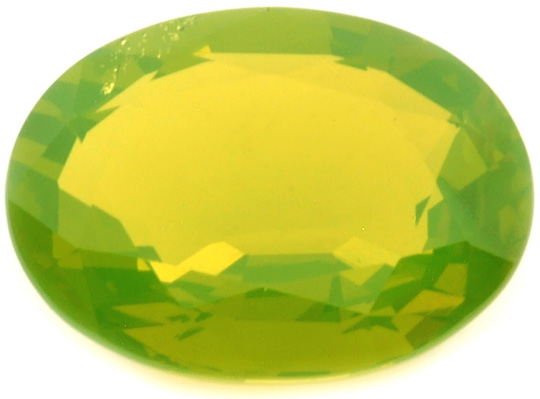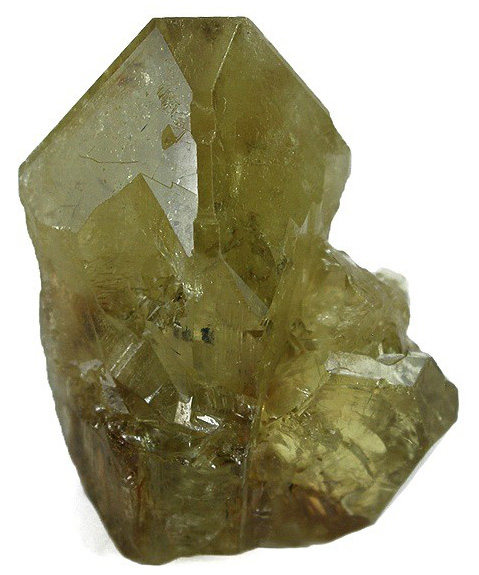Chrysoberyl
Chrysoberyl was first discovered in 1790 by the renowned geologist Abraham Gottlob Werner. Despite the name, it is not actually one of the beryl group of minerals (although it does contain beryllium); but together with alexandrite, it forms its own category.

Above: Cut Chrysoberyl
gemstone
Photo by David Weinberg - released under GNU
The chemical formula of Chrysoberyl is BeAl2O4 - beryllium aluminate. It is one of the hardest naturally-occuring minerals, with a hardness of 8.5 on the Mohs scale - hard enough to scratch quartz. [1] (Corundum has a hardness of 9.0 and diamond has a hardness of 10.0)
Chrysoberyl exists in three main varieties: "ordinary" chrysoberyl (yellow-green), cymophane ("cat's eye") and alexandrite (pink-red; changes color under different light - rare and expensive). Although several other minerals (including tiger's eye, moonstone, aquamarine, tourmaline, apatite and scapolite) display the quality of chatoyance (the "cat's eye effect"), which is caused by needle-like inclusions in the stone, only cymophane is officially named "cat's eye." [2]
Chrysoberyl crystals can take the form of compressed hexagonal prisms or double six-sided pyramids. Individual gemstones over 10 carats are uncommon. Chrysoberyl is said to be a difficult stone to work, however it has the potential to receive a high degree of polish. [3]
Chrysoberyl Varieties
A rare blue-green variety of chrysoberyl has been found in Tanzania and the coloration is due to Vanadium impurities in the mineral structure of the stone. [1]
The majority of chrysoberyl is yellow, yellow-green or brownish. Cymophane, the cat's eye variety, typically occurs in this color range, although some stones have been found which combine the qualities of alexandrite and cymophane, and these have been called "alexandrite cat's eye." [4]
The earliest finds of chrysoberyl were in Brazil and Sri Lanka (then Ceylon) - however by the 1820's it had also been discovered in the USA. [5] Chrysoberyl stones are now found in several locations including several states in the USA, Ural Mountains (Russia), Australia, Zimbabwe, Brazil, Madagascar, Italy and Sri Lanka. The "ordinary" variety seem to be priced around $80 per carat in 2010. [6] Alexandrite is a much more expensive gemstone.

2.2cm long Chrysoberyl from Espirito Santo, Brazil.
Photo by Rob Lavinsky, iRocks.com – CC-BY-SA-3.0 - released under CC-BY-SA-3.0 License
Chrysoberyl - Sources Referenced:
[1] http://en.wikipedia.org/wiki/Chrysoberyl
[2] http://www.galleries.com/minerals/oxides/chrysobe/chrysobe.htm
[3] http://books.google.com/books?id=VLsQAAAAIAAJ&pg=PA81
[4] http://www.farlang.com/gemstones/us-geol-survey-1887/page_031
[5] http://books.google.com/books?id=NnHevrNwsqEC&pg=PA293
[6] http://www.rarestone.com/inventory.html
Back to the Gemstones List home page - over 160 gemstones explored!
Please feel free to link to this page - copy / paste the text below: (click to select)
Privacy Policy | Cookie Policy | GDPR | About This Site / Terms

© gemstoneslist.com


